A Karen National Union (KNU) committee member said that the fighting around Lay Kay Kaw was caused by the Burma Army's (BA) invasion of its peace town in Myawaddy Township, Karen State.
''We have the right to protect ourselves and that’s exactly what our troops did,” explained Padoh Saw Taw Nee, in charge of its foreign affairs department. ''As revolutionary men, we have to be united and fight against the military dictatorship.''
According to a Lay Kay Kaw resident, the BA suffered up to 18 casualties with many wounded when it attacked the town on 15 December, while Karen soldiers captured at least 13 BA soldiers. He told NMG the military dragged away some of their dead and wounded, making it impossible to determine how many BA soldiers actually died.
The man explained that Wednesday’s fighting started after the army attempted to overtake a checkpoint manned by KNU’s military wing, Karen National Liberation Army (KNLA) in Pahekalor, part of Lay Kay Kaw, around 8am. After retreating, the military fired heavy weapons from two locations causing Pahekalor residents to flee and intermittent clashes throughout the day.
People’s Defense Force (PDF) fighters fought alongside the KNLA soldiers, which started after BA’s Light Infantry Brigade 560 raided Lay Kay Kaw on Tuesday. The military abducted 13 people, including National League for Democracy MP Wai Lin Aung, as they searched the town for anti-regime activists and PDF combatants.
With support by Japan’s Nippon Foundation, Lay Kay Kaw was established in February 2015 to house returning refugees from Thailand and internally displaced persons along the border after the KNU signed a union-level peace agreement with Thein Sein’s government several years earlier. Over 3,000 people from 786 families have moved to the town, which is controlled by KNLA’s Brigade 6 and located 15 km south of the border town of Myawaddy.
After the KNU signed the so-called Nationwide Ceasefire Agreement in 2015 with the former Thein Sein government, fighting with the BA began when it started building a series of roads connecting its bases in KNLA’s Brigade 5 controlled area.
Tensions rose after the KNU began welcoming members of the government overthrown by the military during the 1 February coup, as well as protesters resisting the dictatorship. Fighting with the military is happening in all of KNLA’s seven brigades in Karen and Mon states .







